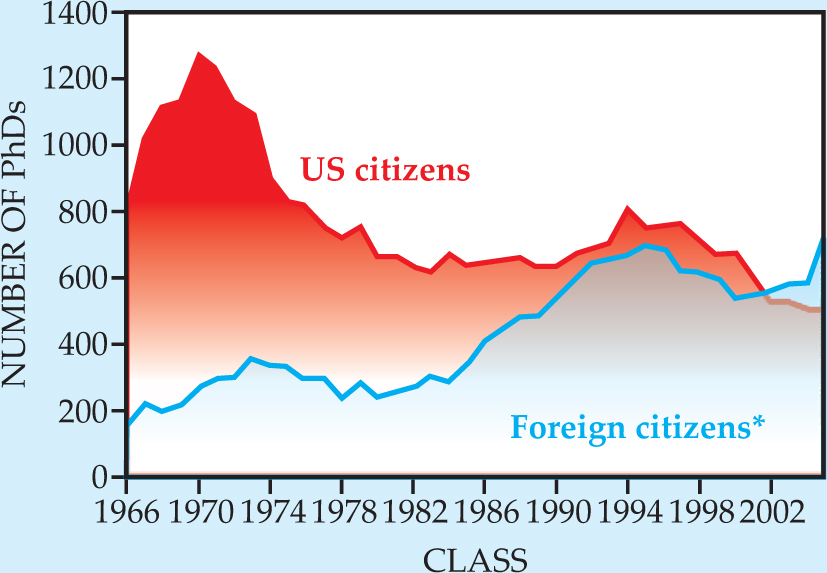Enrollments up, but physics lacks women and minorities
DOI: 10.1063/1.2800093
The numbers of physics and astronomy degrees conferred in the US rose for the class of 2005, according to a recent report by the American Institute of Physics (AIP).
Some 1233 physics PhDs were awarded by 185 departments in 2005, up 14% from the previous year. The number of physics bachelor’s degrees rose for the sixth straight year, with 5113 conferred in 2005, a 40% increase over a recent low in 1999. Astronomy stayed close to its recent average with 91 PhDs, and at the bachelor’s level saw a new record high with 343 degrees awarded in 2005.
For physics PhDs, the gains were due to non-US citizens, who in 2005 made up a record 60% of the graduating class. Over the past decade, the number of US citizens earning physics PhDs has fallen 34%, but according to the AIP report, recent trends in graduate enrollments suggest that US citizens will regain the majority in the next couple of years. In astronomy, one-third of PhD recipients in 2005 were non-US citizens.
At the undergraduate level, the rise in degrees awarded is attributed partly to a larger pool of 18-year-olds and an increase in the proportion who take high-school physics. About 15% of US physics bachelor’s degree recipients eventually receive a physics or astronomy PhD.
Women received 33% of PhDs and 40% of bachelor’s degrees in astronomy, compared with 14% and 21%, respectively, in physics. The representation of women at the PhD level in physics fell for the second year in a row, following a sharp rise that was largely due to non-US citizens. Despite recent overall gains, physics has among the lowest representation of women of all undergraduate fields. Other fields with similarly low percentages of women include engineering and computer science.
African Americans were awarded 3% of bachelor’s degrees and 2% of PhDs in physics in 2005. Some 51% of those physics bachelor’s were bestowed by historically black colleges and universities. Hispanic Americans received 4% and 3%, respectively, of physics bachelor’s and PhD degrees. California confers the greatest number of physics bachelor’s overall, and the largest number to Hispanic Americans, accounting for more than a quarter of them in 2005.
Physics degrees conferred to the class of 2005 represent less than 0.04% of all US bachelor’s degrees and about 2% of those in the natural sciences, math, and engineering. At the PhD level, physics made up 2.8% of all degrees conferred and 4.4% of all degrees in the natural sciences, math, and engineering.
These and other data are presented in the Enrollments and Degrees Report, 2005, available free of charge at http://www.aip.org/statistics/trends/reports/ed.pdf

Citizenship of physics PhDs, 1966–2005
* Foreign citizens include individuals with permanent resident status and those with temporary visas.

More about the Authors
Toni Feder. tfeder@aip.org
